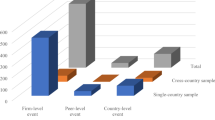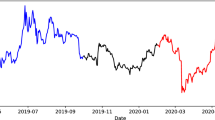Abstract
In this paper we price contingent claims on several foreign assetsthat follow jump-diffusion processes. Discontinuities (jumps) arise dueto the assets' movement in the respective countries, or the exchangerates, or both. We assume the existence of multiple classes (sources)of jumps. Each jump can affect one or more state-variables and is definedby its intensity of arrival and by the joint probability distributionof its magnitude. The existence of jumps gives rise to significant deviationsfrom the joint lognormality assumptions of the multivariate geometricBrownian motion, and affords more flexibility in capturing the empiricallyobserved asymmetry and fat tails in asset returns. Analytic solutionsare provided for the European option on the best of several assets withoutor with exchange rate (quanto-type) protection. A Markov-chainnumerical method that can also handle American claims is given and itsaccuracy is demonstrated. Neglecting the effect of jumps causes seriousmisspricing and leads to erroneous decision-making when purchasing orexercising such options.
Similar content being viewed by others
References
Amin, K. I. (1993). “Jump-Diffusion Option Valuation in Discrete Time,” Journal of Finance 48, 1833¶1863.
Andersen, L. and J. Andreasen. (2001). “Jump-Diffusion Processes: Volatility Smile Fitting and Numerical Methods for Option Pricing,” Review of Derivatives Research 4, 231¶262.
Andersen, T. G., T. Bollerslev, F. X. Diebold, and P. Labys. (2001). “The Distribution of Realized Exchange Rate Volatility,” Journal of the American Statistical Association 96, 42¶55.
Andersen, T. G., T. Bollerslev, F. X. Diebold, and P. Labys. (2001a). “Modeling and Forecasting Realized Volatility,” Working Paper # 276, Kellogg (NWU) Finance Department.
Andreasen, J. (1998). “The Pricing of Discretely Sampled Asian and Lookback Options: A Change of Numeraire Approach,” Journal of Computational Finance 2, 5¶30.
Bakshi, G., C. Cao, and Z. Chen. (1997). “Empirical Performance of Alternative Option Pricing Models,” Journal of Finance 52, 2003¶2049.
Bardhan, I. (1995). “Exchange Rate Shocks, Currency Options and the Siegel Paradox,” Journal of International Money and Finance 14, 441¶458.
Bates, D. S. (1991). “The Crash of '87: Was it Expected? The Evidence from Options Markets,” Journal of Finance 46, 1009¶1044.
Bates, D. S. (1996). “Jumps and Stochastic Volatility: Exchange Rate Processes Implicit in Deutsche Mark Options,” Review of Financial Studies 9, 69¶107.
Bates, D. S. (1996a). “Dollar Jump Fears, 1984–1992: Distributional Abnormalities Implicit in Currency Futures Options,” Journal of International Money and Finance 15, 65¶93.
Boyle, P. P., J. Evnine, and S. Gibbs. (1989). “Numerical Evaluation of Multivariate Contingent Claims,” Review of Financial Studies 2, 241¶250.
Cox, J., J. Ingersoll, and S. Ross. (1985). “An Intertemporal General Equilibrium Model of Asset Prices,” Econometrica 53, 363¶384.
Das, S. R. and R.K. Sundaram. (1999). “Of Smiles and Smirks:A term Structure Perspective,” Journal of Financial and Quantitative Analysis 34, 211–239.
Duffie, D., J. Pan, and K. Singleton. (2000). “Transform Analysis and Asset Pricing for Affine Jump-Diffusions,” Econometrica 68, 1343–1376.
Dumas, B., L. P. Jennergreen, and B. Näslund. (1995). “Siegel's Paradox and the Pricing of Currency Options,” Journal of International Money and Finance 14, 213¶223.
Eraker, B., M. Johannes, and N. Polson. (2000). “The Impact of Jumps in Volatility and Returns,” Working Paper.
Gukhal, C. R. (2001). “Analytical Valuation of American Options on Jump-Diffusion Processes,” Mathematical Finance 11, 97¶115.
Huang, J. and J.-S. Pang. (1998). “Option Pricing and Linear Complementarity,” The Journal of Computational Finance 2, 31¶60.
Hull, J. and A. White. (1987). “The Pricing of Options with Stochastic Volatilities,” Journal of Finance 42, 281¶300.
Johnson, H. (1987). “Options on theMaximum or the Minimum of Several Assets,” Journal of Financial and Quantitative Analysis 22, 227¶283.
Kushner, H. and G. DiMasi. (1978). “Approximations for Functionals and Optimal Control on Jump Diffusion Processes,” Journal of Mathematical Analysis and Applications 40, 772¶800.
Margrabe, W. (1978). “The Value of an Option to Exchange One Asset for Another,” Journal of Finance 33, 177¶186.
Martzoukos, S. H. (1996). “Multivariate Contingent Claims with Stochastic Cost of Exercise and Multiplicative Uncertainties,” Working Paper #1996-42 SBPM, The GeorgeWashington University (appeared in Journal of Multinational Financial Management 11, 1¶15, with slightly altered title).
Martzoukos, S. H. and L. Trigeorgis. (2002). “Real (Investment) Options with Multiple Types of Rare Events,” European Journal of Operational Research 136, 696¶706.
Merton, R.C. (1976). “Option Pricing when Underlying Stock Returns are Discontinuous,” Journal of Financial Economics 3, 125¶144.
Reiner, E. (1992). “Quanto Mechanics,” RISK (March), 59¶63.
Scott, L. (1987). “Option Pricing when the Variance Changes Randomly: Theory, Estimators, and Applications,” Journal of Financial and Quantitative Analysis 22, 419¶438.
Stulz, R. (1982). “Options on the Minimum or the Maximum of Two Risky Assets: Analysis and Applications,” Journal of Financial Economics 10, 161¶185.
Wiggins, J. (1987). “Option Values Under Stochastic Volatilities,” Journal of Financial Economics 19, 351¶372.
Author information
Authors and Affiliations
Rights and permissions
About this article
Cite this article
Martzoukos, S.H. Contingent Claims on Foreign Assets Following Jump-Diffusion Processes. Review of Derivatives Research 6, 27–45 (2003). https://doi.org/10.1023/A:1022822004204
Issue Date:
DOI: https://doi.org/10.1023/A:1022822004204




